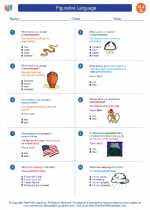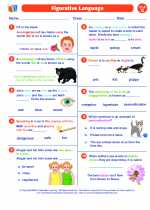Figurative Language Study Guide
What is Figurative Language?
Figurative language is using words and expressions to convey a meaning that is different from the literal interpretation. It adds depth and creativity to writing.
Types of Figurative Language:
- Simile: Comparing two things using "like" or "as". Example: He eats like a pig.
- Metaphor: Implied comparison between two unlike things. Example: Her eyes were sparkling diamonds.
- Personification: Giving human characteristics to something non-human. Example: The wind whispered through the trees.
- Hyperbole: Exaggerated statements or claims not meant to be taken literally. Example: I've told you a million times.
- Onomatopoeia: Words that imitate the sound they represent. Example: The bees were buzzing in the garden.
- Idioms: Expressions that have a figurative meaning unrelated to the literal meaning of the words. Example: It's raining cats and dogs.
- Alliteration: Repetition of initial consonant sounds. Example: Peter Piper picked a peck of pickled peppers.
- Assonance: Repetition of vowel sounds within words. Example: The cat ran after the ball.
- Consonance: Repetition of consonant sounds within or at the end of words. Example: Mike likes his new bike.
- Imagery: Using descriptive language to create vivid mental images. Example: The sunset was a blazing ball of fire.
Why is Figurative Language Important?
Figurative language helps writers convey emotions, create vivid imagery, and engage readers in a more profound and imaginative way. It adds depth and creativity to writing and enhances the reader's experience.
How to Identify Figurative Language:
Look for words or phrases that are not meant to be taken literally. They often create a visual or sensory experience for the reader.
Practice:
Here are some examples of sentences. Identify the type of figurative language used in each.
- The stars danced playfully in the moonlit sky.
- His words cut deeper than a knife.
- The sun kissed the flowers good morning.
Now that you have a good understanding of figurative language, keep practicing and identifying different types in various texts!
[Figurative Language ] Related Worksheets and Study Guides:
.◂English Language Arts Worksheets and Study Guides Seventh Grade. Figurative Language

 Activity Lesson
Activity Lesson
 Worksheet/Answer key
Worksheet/Answer key
 Worksheet/Answer key
Worksheet/Answer key
 Worksheet/Answer key
Worksheet/Answer key
 Worksheet/Answer key
Worksheet/Answer key
